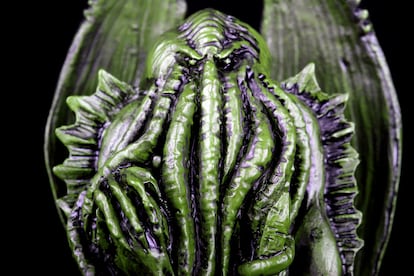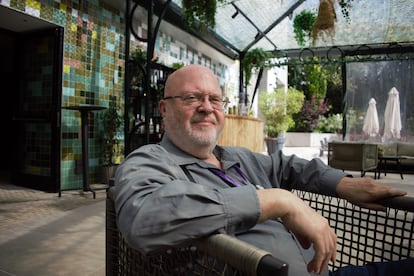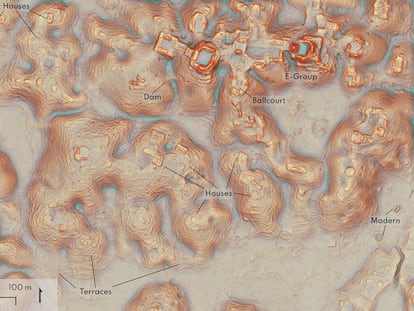How Lovecraft found new fans thanks to a terrifying role-playing game
Sandy Petersen is the creator of ‘Call of Cthulhu,’ the popular RPG inspired by the works of the fantasy author, as well as the designer of the famous video game ‘Doom’

It was a eureka moment. That’s how Sandy Petersen, 69, described his game-changing realization at the Celsius 232 festival in Avilés, an annual event that has celebrated the best of the fantasy genre for 13 years.
“I realized that the gameplay loop in Dungeons & Dragons was straightforward: kill the bad guy, level up, kill the bad guy, level up,” he tells EL PAÍS. “But I knew that approach wouldn’t work for a game based on Lovecraft’s universe. That didn’t make sense. When you’re being chased by cosmic horrors and fanatical cultists, combat couldn’t be the answer, because what you were facing was too terrifying. That’s when it hit me: the game cycle needed to revolve around investigation. Players would investigate mysteries and become absorbed by them. That completely transformed the game’s dynamics.”
The game Sandy Petersen is referring to is Call of Cthulhu, one of the most influential role-playing franchises — interactive storytelling games in which players embody fictional characters under the guidance of a narrator, known as the Game Master. In countries like Japan, Call of Cthulhu has even eclipsed the popularity of Dungeons & Dragons, which celebrates its 50th anniversary this year.
Petersen created Call of Cthulhu in 1981 after being commissioned by Chaosium, a publisher that would become iconic in the role-playing world thanks to titles like Runequest and especially Call of Cthulhu. The game’s biggest impact was its transformation of the author H.P. Lovecraft and his mythos into staples of pop culture. “Whenever I see a Cthulhu [one of Lovecraft’s most famous deities, a colossal, cephalopod-like entity with vast wings] plush or a t-shirt like yours, I think Lovecraft partly owes that to me. I can only be proud to have brought it to the general public.”
Originally, Petersen hadn’t expected Call of Cthulhu to achieve mainstream success. “It was simply that [Chaosium] had the rights to adapt Lovecraft. I thought it would be a niche game, selling a few thousand copies to whoever was a Lovecraft fan in the early 1980s and then fading away. But it struck a chord with people. So much so that thousands of people say they started reading Lovecraft because of my game. In 2010, I was invited to a Lovecraft film festival and given a bust of him after being told he’s as popular as he is today partly because of what I did with Call of Cthulhu.”

This accomplishment alone would have secured Sandy Petersen’s place in pop culture history. But Petersen’s career continued to break new ground. A decade after creating Call of Cthulhu, Petersen joined forces with developers John Carmack and John Romero, who were working on a violent and groundbreaking game: Doom.
Petersen was brought in to replace another designer who was responsible for creating most of the game’s levels. The skills he had developed creating Call of Cthulhu —especially in building atmospheric horror — shaped Doom’s pixelated labyrinths.
“I used that experience to make the levels scary,” he recalls. “For instance, I’ve always thought it’s scarier to catch a glimpse of the horror to come than to rely on jump scares,” he says.
While Romero, another Doom designer, would teleport enemies behind players for a shock, Petersen opted for a more subtle approach. “I preferred to drop hints — a glimpse of a monster or a creepy detail. Or, players would walk into a room and find a pedestal spotlighted, and on it, something powerful like the BFG [Big Freaking Gun, the game’s most powerful weapon]. But I’d set it up so they knew that as soon as they picked it up, all hell was going to break loose.”
Designing these horror-filled dungeons and mazes was more artisanal than one might think. “For many, I’d sketch a layout on paper before moving to the level editor [a computer tool for creating a video game level]. Some levels seemed to grow by themselves,” says Petersen. “Suddenly, I’d have an idea for a section. To use a film analogy, it would be ‘the cool scene.’ Then I would figure out how to get to it: a staircase here, and then an open space, and then you go up again, but behind you a tide of acid begins to rise, and now you have to find a way out of the acid. And so I would build, sometimes also trying to evoke in the player’s mind that there was more than what they saw. For example, one level was shaped like a giant hand, and when you realized, you would start to navigate it by imagining which finger you were on.”

Petersen’s passion for game design, whether digital or tabletop, was evident in his daily routine in Avilés. Each day, he’d start with breakfast at the Palacio de Avilés, stroll a few hundred meters to the arcade near the cultural center, and spend the rest of the day there, at the tables where open-air role-playing games of Call of Cthulhu were played. For the six days of the Celsius 232 festival, fans had the unique chance to play alongside the game’s creator, who, naturally, was one of the gang.
Sign up for our weekly newsletter to get more English-language news coverage from EL PAÍS USA Edition
Tu suscripción se está usando en otro dispositivo
¿Quieres añadir otro usuario a tu suscripción?
Si continúas leyendo en este dispositivo, no se podrá leer en el otro.
FlechaTu suscripción se está usando en otro dispositivo y solo puedes acceder a EL PAÍS desde un dispositivo a la vez.
Si quieres compartir tu cuenta, cambia tu suscripción a la modalidad Premium, así podrás añadir otro usuario. Cada uno accederá con su propia cuenta de email, lo que os permitirá personalizar vuestra experiencia en EL PAÍS.
¿Tienes una suscripción de empresa? Accede aquí para contratar más cuentas.
En el caso de no saber quién está usando tu cuenta, te recomendamos cambiar tu contraseña aquí.
Si decides continuar compartiendo tu cuenta, este mensaje se mostrará en tu dispositivo y en el de la otra persona que está usando tu cuenta de forma indefinida, afectando a tu experiencia de lectura. Puedes consultar aquí los términos y condiciones de la suscripción digital.
More information
Archived In
Últimas noticias
A survivor’s account of the Interoceanic Train accident: ‘We were scared because of the speed on the curve’
The Interoceanic Train, the Mexican alternative to the Panama Canal
What is known about the Interoceanic Train derailment in Oaxaca
Trump turns a Minnesota fraud allegation into ammunition for his MAGA army against Democrats
Most viewed
- Oona Chaplin: ‘I told James Cameron that I was living in a treehouse and starting a permaculture project with a friend’
- Reinhard Genzel, Nobel laureate in physics: ‘One-minute videos will never give you the truth’
- Why the price of coffee has skyrocketed: from Brazilian plantations to specialty coffee houses
- Pablo Escobar’s hippos: A serious environmental problem, 40 years on
- Chevy Chase, the beloved comedian who was a monster off camera: ‘Not everyone hated him, just the people who’ve worked with him’










































